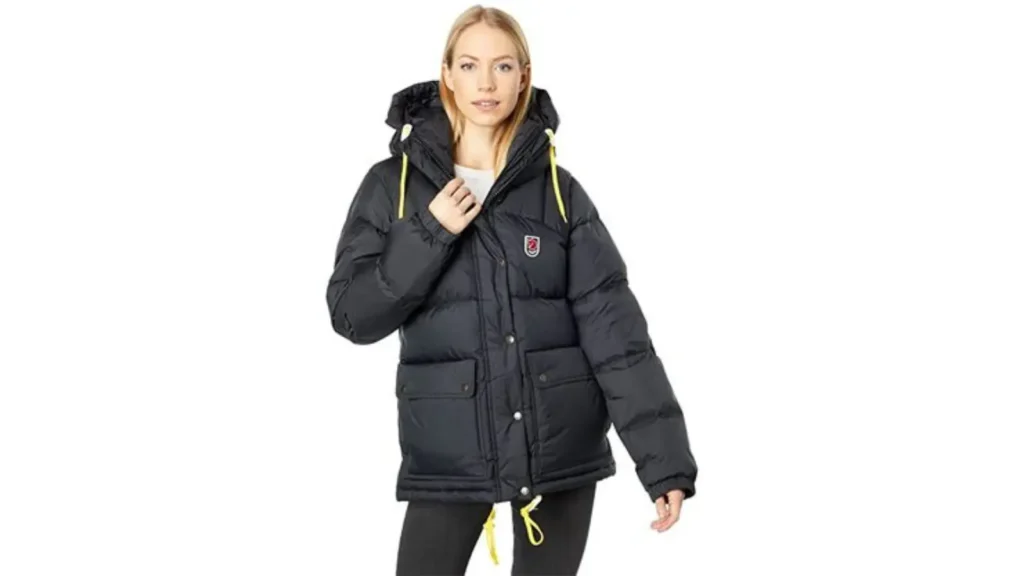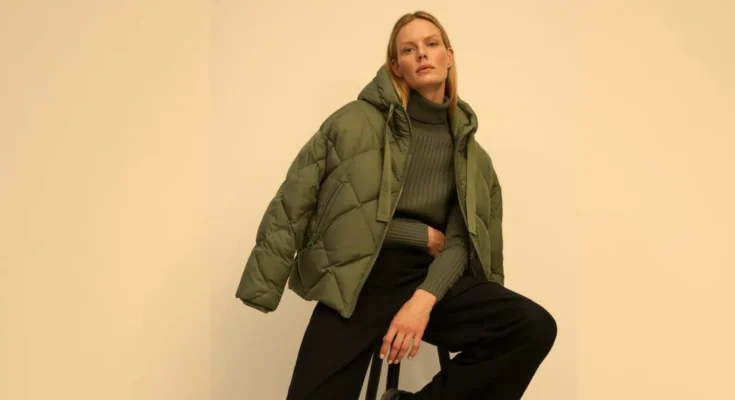The choice between down and synthetic jackets represents a pivotal decision for those seeking reliable warmth and comfort in cold weather. Both types of insulation have their distinct advantages and considerations, influencing the preferences of outdoor enthusiasts and casual wearers alike.
Down jackets rely on the natural loftiness of bird feathers for insulation, offering unparalleled warmth-to-weight ratios. On the other hand, synthetic jackets employ man-made materials like polyester fibres to mimic down-insulating properties, excelling in moisture resistance and affordability.
This comparison explores the key differences between down and synthetic jackets, aiding individuals in making informed decisions based on their specific needs and preferences.
Down Jacket
A down jacket is a type of outerwear designed to provide insulation by using the soft and fluffy undercoating of duck or goose feathers. This natural insulation, known as down, creates a layer of warmth that traps heat and keeps the wearer comfortable in cold temperatures. Down jackets are renowned for their exceptional warmth-to-weight ratio, making them lightweight and compressible, ideal for outdoor activities.

The Anatomy of a Down Jacket
Outer Shell:
- The outer shell of a down jacket is typically made from durable and water-resistant materials like nylon or polyester. This layer protects the delicate downfilling from moisture, ensuring that the jacket retains its insulation properties even in wet conditions.
Insulation:
- The insulation is the heart of a down jacket. Goose down is widely regarded as superior to duck down due to its larger and more resilient clusters. The higher fill power indicates superior insulation, with 600-fill being a good starting point for quality jackets. However, premium options can go up to 900-fill power.
Baffles:
- Baffles are stitched compartments that keep the down in place, preventing it from shifting and creating cold spots. Jackets may have different baffling designs, such as box baffles, sewn-through baffles, or a combination of both, each affecting the distribution of down and the overall warmth of the jacket.
Types of Down Jackets
Puffer Jackets:
- Puffer jackets are a classic style, characterized by their quilted appearance and excellent insulation. They are versatile and can be used for various activities, from casual wear to outdoor adventures.
Hooded Jackets:
- Hooded down jackets offer additional protection against cold winds and snow, making them a popular choice for winter sports enthusiasts or those living in colder climates.
Packable Jackets:
- Packable down jackets are designed to be easily compressed and stored in a small pouch, making them convenient for travel and outdoor activities where space is limited.
Sustainability in Down Jackets
As the fashion industry places a growing emphasis on sustainability, the sourcing of down has come under scrutiny. Responsible brands now focus on ethical and humane practices, ensuring that the down used in their jackets is obtained without harm to animals. Look for jackets that carry the Responsible Down Standard (RDS) certification, indicating that the down was ethically sourced.
Additionally, some brands are exploring alternative insulating materials, such as recycled synthetic fibres or plant-based options, providing eco-friendly alternatives to traditional down jackets.
Care and Maintenance
To prolong the life and performance of your down jacket, proper care is essential. Follow these tips:
Storage:
- Store your down jacket in a cool, dry place. Avoid compressing it for extended periods, as this can affect its loft and insulation properties.
Cleaning:
- Check the care instructions on your jacket, but most down jackets can be machine-washed using a gentle detergent. Use a front-loading machine to prevent damage to the baffles.
Drying:
- Dry your down jacket thoroughly to prevent mildew. Tumble dry on low heat with tennis balls or dryer balls to help fluff up the down clusters.
Synthetic jacket
A synthetic jacket is an outerwear that uses man-made materials like polyester fibers for insulation, unlike traditional down jackets that rely on natural feathers. These jackets offer advantages such as moisture resistance, quick drying, and affordability. Common synthetic insulation technologies include Primaloft, Thinsulate, and Polartec Alpha. They are popular for various outdoor activities due to their versatility and performance characteristics. Some brands also incorporate recycled materials for a more sustainable approach.

The Technology Behind Synthetic Jackets
Materials:
- Unlike down jackets, synthetic jackets use man-made materials as insulation. Commonly employed synthetic insulators include polyester fibers, which are designed to mimic the warmth-trapping qualities of down. These materials are often water-resistant and dry quickly, making synthetic jackets suitable for various weather conditions.
Construction:
- Synthetic jackets use innovative construction techniques to create warmth without the need for natural feathers. High-quality synthetic jackets often feature baffles or quilting to distribute insulation evenly, preventing cold spots and ensuring consistent warmth.
Advantages of Synthetic Jackets
Moisture Resistance:
- Synthetic insulation retains its loft and insulating properties even when wet, making synthetic jackets an excellent choice for damp and rainy conditions. Unlike down, which tends to lose its effectiveness when exposed to moisture, synthetic jackets provide reliable warmth in various weather scenarios.
Quick Drying:
- Synthetic materials dry faster than down, allowing wearers to stay comfortable and warm even after exposure to rain or snow. This quick-drying feature is especially beneficial for outdoor activities where staying dry is crucial.
Hypoallergenic:
- Some individuals may be allergic to down or feathers, making synthetic jackets a hypoallergenic alternative. People with allergies or sensitivities can comfortably enjoy the warmth and insulation provided by synthetic materials.
Affordability:
- Synthetic jackets are often more budget-friendly than their down counterparts. This affordability makes them an attractive option for those seeking high-quality outdoor gear without breaking the bank.
Types of Synthetic Jackets
Primaloft:
- Primaloft is a popular synthetic insulation known for its excellent warmth-to-weight ratio, water resistance, and compressibility. Many leading outdoor brands incorporate Primaloft technology into their jackets for reliable performance.
Thinsulate:
- Thinsulate is another widely used synthetic insulation that provides exceptional warmth without adding bulk. It is often found in a variety of outerwear, including jackets, gloves, and boots.
Polartec Alpha:
- Polartec Alpha is a more recent innovation in synthetic insulation, designed to regulate body temperature during both rest and activity. Jackets featuring Polartec Alpha provide warmth when needed and breathability during periods of exertion.
Sustainability in Synthetic Jackets
As the demand for sustainable fashion grows, manufacturers are exploring eco-friendly options for synthetic jackets. Some brands use recycled polyester or other recycled materials in the production of their jackets, reducing the environmental impact associated with virgin synthetic fibers. Additionally, advancements in manufacturing processes are aiming to minimize energy consumption and waste.
Care and Maintenance
Caring for a synthetic jacket is generally straightforward. Follow these tips to keep your synthetic jacket in optimal condition:
Machine Washing:
- Check the care instructions, but most synthetic jackets can be machine-washed with a mild detergent. Avoid using fabric softeners, as they can affect the jacket’s water-resistant properties.
Drying:
- Air-dry your synthetic jacket or use a tumble dryer on low heat. Be cautious with high heat, as it can damage synthetic fibres. Adding tennis balls or dryer balls during drying can help restore the loft.
How Down vs Synthetic Jackets Are Different?
| Feature | Down Jackets | Synthetic Jackets |
| Insulation Material | Natural bird feathers (usually duck or goose down) | Slower due to natural fibres |
| Warmth-to-Weight Ratio | Excellent; high loft provides exceptional warmth | Good; insulation effectiveness varies |
| Moisture Resistance | Poor; loses insulation when wet | Excellent; retains warmth even when wet |
| Drying Time | Ethical sourcing is crucial; the potential environmental impact | Faster; dries quickly after exposure to rain |
| Hypoallergenic | No; may cause allergies in some individuals | Yes; suitable for those with allergies |
| Affordability | Typically more expensive | Generally more affordable |
| Weight and Compressibility | Lightweight and highly compressible | Lightweight and compressible |
| Sustainability | Ethical sourcing is crucial; potential environmental impact | Some use recycled materials for eco-friendliness |
| Versatility | Suitable for various conditions, but best in dry climates | Versatile; performs well in wet conditions |
Conclusion:
Choosing between down and synthetic jackets comes down to personal preferences and needs. Down jackets are super warm and lightweight but may not be as effective when wet and can raise ethical concerns. Synthetic jackets, on the other hand, are affordable, moisture-resistant, and suitable for various conditions. It’s about balancing warmth, budget, and how you plan to use the jacket – whether it’s for dry climates or wet adventures. Understanding these differences helps you pick the jacket that fits your style and requirements best.




